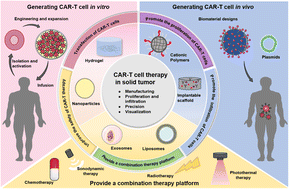Recent advances in biomaterial designs for assisting CAR-T cell therapy towards potential solid tumor treatment
Abstract
Chimeric antigen receptor T (CAR-T) cells have shown promising outcomes in the treatment of hematologic malignancies. However, CAR-T cell therapy in solid tumor treatment has been significantly hindered, due to the complex manufacturing process, difficulties in proliferation and infiltration, lack of precision, or poor visualization ability. Fortunately, recent reports have shown that functional biomaterial designs such as nanoparticles, polymers, hydrogels, or implantable scaffolds might have potential to address the above challenges. In this review, we aim to summarize the recent advances in the designs of functional biomaterials for assisting CAR-T cell therapy for potential solid tumor treatments. Firstly, by enabling efficient CAR gene delivery in vivo and in vitro, functional biomaterials can streamline the difficult process of CAR-T cell therapy manufacturing. Secondly, they might also serve as carriers for drugs and bioactive molecules, promoting the proliferation and infiltration of CAR-T cells. Furthermore, a number of functional biomaterial designs with immunomodulatory properties might modulate the tumor microenvironment, which could provide a platform for combination therapies or improve the efficacy of CAR-T cell therapy through synergistic therapeutic effects. Last but not least, the current challenges with biomaterials-based CAR-T therapies will also be discussed, which might be helpful for the future design of CAR-T therapy in solid tumor treatment.

- This article is part of the themed collections: Theranostic nanoplatforms for biomedicine, 2024 Nanoscale HOT Article Collection and Recent Review Articles


 Please wait while we load your content...
Please wait while we load your content...